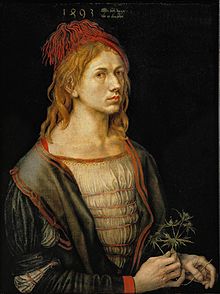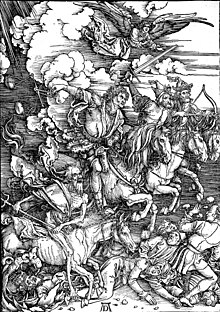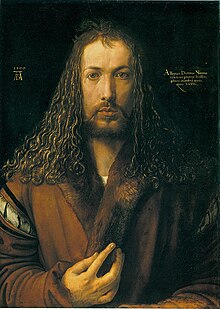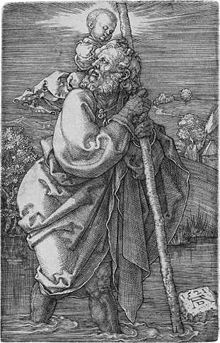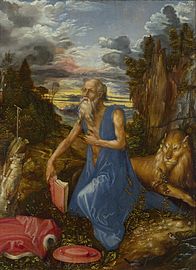Albrecht Dürer
Albert Dürer (in German, Albrecht Dürer; Nuremberg, May 21, 1471-ib., April 6, 1528) is the most famous artist of the German Renaissance, known throughout the world for his paintings, drawings, prints, and theoretical writings on art.
Famous in half of Europe before he was thirty thanks to the success of his series of woodcuts of the Apocalypse (1498), he exerted a decisive influence on artists of the sixteenth century, both German and the Netherlands (especially in Lucas van Leyden). He came to be admired by Italian masters like Raphael Sanzio and Titian; It is also confirmed that he had contacts with geniuses such as Leonardo da Vinci and Giovanni Bellini. His engravings were widely distributed and inspired many subsequent artists, including Spanish Baroque painting, the 19th-century Nazarene movement, and early 20th-century German expressionists.
Life and work
He was born on May 21, 1471 in Nuremberg, a city to which he was intimately attached. His father was a Hungarian goldsmith who emigrated to German lands and was the first teacher of his son. Albrecht Dürer the Elder (1427-1502) was born in the Hungarian town of Ajtós, located next to the city of Gyula. He was originally named Albert Ajtósi, when he arrived in Germany he translated his surname to "Türer" and then to "Dürer", according to the local dialect. The surname means "maker of doors", and in fact, Dürer would have a door as a reason for his coat of arms.
From his early training, the young Dürer inherited the legacy of 15th-century German art, in which late-Gothic Flemish painting was very present. German artists had no difficulty in adapting their own Gothic tradition to that of Flemish artists, such as Robert Campin, Jan van Eyck and, above all, Rogier van der Weyden.
The northern people's empirical concept of the world (based more on observation than theory) was the common thread. During the 16th century, the strengthening of ties with Italy through trade and the spread of the ideas of Italian humanists by Northern Europe infused new artistic ideas into the traditionally more conservative German art world.
German artists found it difficult to reconcile their medieval imagery—rendered with rich textures, brilliant colors, and highly detailed figures—with Italian artists' emphasis on classical antiquity, mythological themes, and idealized figures. The task that Dürer set himself was to provide his compatriots with a model with which they could combine an empirical interest in naturalistic detail with the more theoretical aspects of Italian art.
In his abundant correspondence -especially in the letters to the humanist Willibald Pirckheimer, his lifelong friend- and in various publications, Dürer emphasized that geometry and measurements were the key to understanding Italian Renaissance art and, through him, of classical art.
On Dürer's list of friends was the Austrian Johann Stabius, an author who provided him with insights and details on the construction of sundials. Among the notes he left in his diary, it is worth mentioning a description of a nightmare he had one Pentecost night in 1525, where he saw waterspouts falling from the sky. Marguerite Yourcenar made an interesting analysis in her book Time, great sculptor .
From about 1507 until his death he made notes and drawings for his best-known treatise, Vier Bücher von menschlicher Proportion (Four Books on Human Proportions, published posthumously in 1528). However, other contemporary artists of his, with a more visual than literary orientation, paid more attention to his engravings, both on copper plates and xylographs, than to his writings aimed at guiding them in the modernization of their art with cutting nudes. classic and idealized themes, typical of the Italian Renaissance.
Learning and first trip
Qualified as a child prodigy, Dürer had to learn to draw with his father and possibly already then became familiar with metal engraving, since his father was a goldsmith. An eloquent example of his precocious ability to draw is the Self-portrait of him at 13 years old (1484), made with silverpoint, a material that does not allow corrections.
In 1486, at the age of fifteen, Dürer entered the workshop of Michael Wolgemut as an apprentice, where between 1488 and 1493 he undertook the considerable task of making numerous woodcuts to illustrate the Nuremberg Chronicle (1493) by Hartmann Schedel, possibly the most ambitious and famous incunabula produced in Europe. Dürer probably received extensive instruction on how to make the drawings for the woodblocks. Throughout the Renaissance period, southern Germany was the center of many publications and it was common for painters to also be qualified to make woodcuts and engravings for them.
As was the custom among young men who had finished their apprenticeship, Dürer emancipated himself from his teacher Wolgemut and undertook a study tour in 1490. In 1492 he arrived in Colmar, where he attempted to enter the studio of the German painter and engraver Martin Schongauer who, unknown to Dürer, had died in 1491.
Schongauer's brothers advised him to go to the publishing center in Basel, Switzerland, to look for a job. In Basel and later in Strasbourg, Dürer produced illustrations for various publications, of which the first seems to be a Saint Jerome in his study made in xylography for a book of 1492; its original matrix is kept in the Basel Art Museum. Dürer's most relevant work in Basel must have been the illustration for the satirical book Das Narrenschiff by Sebastian Brant in 1494 (translated in 1507 as The Ship of Fools); some 75 of the 116 images in the work are attributed to him.
During this early stage of his life, between his apprenticeship and his return to Nuremberg in 1494, his art reflects an enormous facility in drawing and a meticulous observation of detail. These qualities are especially evident in a series of self-portraits, among which is the already mentioned one from 1484 (Albertina, Vienna), another self-portrait with a serious expression drawn in 1491 (Collections of the University, Erlangen, Germany), and another already in colors, painted in oil on parchment, in which he appears as a self-confident young man (1493, Louvre Museum).
First trip to Italy (1494-95)
In pursuance of an arranged marriage during his absence, Dürer married in Nuremberg in 1494 Agnes Frey, daughter of a financially well-off blacksmith. At that time, any artist who wanted to open his own workshop had to be married. The new couple never had children, and the marital relationship was not good, as can be deduced from several letters where the artist and his friend Pirckheimer spoke negatively about Agnes.
Shortly after the wedding, Dürer traveled without his wife to Italy. There he made painstakingly detailed watercolors of landscapes, probably during his return trip, such as a view of the Castle of Trent (National Gallery, London).
During the next ten years in Nuremberg, from 1495 to 1505, he produced a large number of etchings that helped establish his fame. Notable among them are the xylographs of the Apocalypse series (1498), Men's Bath and Samson with the Lion, and the burin engravings The Great Fortune (1501-1502) and The Fall of Man (1504). These and other works from this period show, as a whole, an increasing technical mastery in the art of both techniques, a handling of human proportions based on the texts of the Roman writer Vitruvius and a brilliant ability to incorporate details of nature. in works that reflect the environment with great realism.
In 1498 he painted his Self-portrait in the Prado Museum (Madrid) and in 1500 the one in the Old Pinacoteca in Munich, in which he is represented with the characteristics that are usually attributed to Christ and visually expresses the concern he showed during all his life to elevate the category of the artist above that of the mere craftsman.
Second trip to Italy (1505-1507)
Dürer traveled to Italy again between 1505 and 1507. In Venice he met the great master Giovanni Bellini and other artists, and was commissioned by the German Merchants Foundation (Fondaco dei Tedeschi) for an important work: the altarpiece of The Feast of the Rosary (1506, National Gallery in Prague). Also on those dates he painted (in barely five days, as he inscribed in the work itself) the table Jesus among the doctors (Madrid, Thyssen-Bornemisza Museum).
In 1507 he returned to Nuremberg and two years later bought a four-story house; it would be his home and workshop for the rest of his life (it is currently open as a museum). A second period of enormous artistic production began in those years with works such as the altarpiece for the Dominican church in Frankfurt am Main (1508-1509, destroyed in a fire in 1729), the panel of the Adoration of the Trinity (1508-1511, Museum of Art History, Vienna), the tables of Adam and Eve (1507, Museo del Prado), portraits (as Girl with a red beret) and numerous engravings.
Among the latter are two series on the Passion (the Great Passion and the Small Passion), another on the Life of the Virgin, a 3.70 meter high Triumphal Arch designed by various artists and engraved on 195 wooden plates (commissioned by the Holy Roman Emperor Maximilian I), and three magisterial images: The knight, Death and the Devil (1513), Saint Jerome in his cabinet (1514) and Melancholy (1514). In 1515 he published a large woodcut of a rhinoceros arriving in Lisbon; This image became famous for centuries, and a copy of it fetched $866,000 (641,000 euros) at auction in 2013, a record price paid for an engraving by the artist Through line engraving, Dürer managed to create different ranges of shading and textures with which he managed to capture three-dimensional shapes with a mastery never before achieved.
He is taken in by the Fugger family, of whose members he makes some portraits.
Last trip and last works
In 1520 he learned that Charles I, successor to Maximilian I, was to travel from Spain to Aachen to be crowned Holy Roman Emperor. Dürer had received an annual pension from Maximilian and intended for Charles I to keep that allowance. He undertook the trip to Aachen with his wife, which he financed by selling engravings and other works along the way, and from there he went to the Netherlands between 1520 and 1521. Possibly the most relevant Durerian painting of that period was Saint Jerome in meditation (Lisbon, Museu Nacional de Arte Antiga) that he created in Antwerp for the Portuguese diplomat Ruy Fernández de Almeida. In Ghent they told him of the discovery of a beached whale; he hastened to the coast to see her, but was caught in a storm and fell ill. His diary provides us with a fascinating account of these voyages, of the audiences with the monarchs, and of the receptions he received from his fellow artists, such as Lucas van Leyden, especially in Antwerp. His audience with Carlos I was very satisfactory, but there are those who attribute to this trip the cause of some health problems (malaria?) that affected the artist during his last years.
He returned to Nuremberg, where he would remain until his death on April 6, 1528. In his last years, suffering from health ailments and possible depression, he reduced his artistic production in favor of his theoretical or written. His last pictorial works are two large tables on which Four Apostles are represented (circa 1526, Alte Pinakothek Munich), which he offered as a gift to the city of Nuremberg; and his last burin engraving is a Portrait of Erasmus of Rotterdam of the same year.
Later influence
Dürer's art has exerted an intense and lasting influence on Western art, mainly thanks to the massive circulation of his engravings, both originals and copies. Dürer is, like Rembrandt and Francisco de Goya, one of the very few geniuses of European art who created paintings and engravings with the same dedication. In fact, Durer's production in print and on paper (drawings, watercolours) is numerically far superior to pictorial: compared to a catalog of close to 120 preserved paintings, some 1,200 drawings and some 450 engraved images are catalogued. Of these, 350 are woodcuts and 105 are engravings on metal matrices (copper, iron), the vast majority worked with a burin (Dürer produced only three drypoint engravings and six etchings).
Already in life, Dürer enjoyed great fame not only in Central Europe, but also in the Netherlands, Spain and Italy, mainly for his prints, which were frequently copied. In 1506, during his stay in Venice, Dürer denounced the Italian Marcantonio Raimondi for using his anagram on copies of his engravings. This conflict was resolved with a Solomonic ruling: Dürer was guaranteed protection for his monogram in Venetian territory, although not for his compositions. They could be reproduced, but without the monogram, which would help to differentiate between Dürer's genuine engravings and his copies. This is one of the first antecedents of the right to protection of intellectual property.
Dürer's pictorial production is scarcer due in part to the time each work required in design and execution. Dürer had illustrious clients from an early date, such as Frederick III of Saxony and Maximilian I, which ensured him economic stability that allowed him to focus on the most ambitious commissions and dedicate the necessary time to them. His paintings initially accumulated in a few collections and churches, so the rapid spread of his art was due to the graphic medium.
Dürer produced and distributed his prints with a shrewd commercial vision. The most sophisticated images, in many cases allegorical and/or nude, were personally engraved by him with a burin down to the last detail, with an exhausting and perfectionist technique, and they were sold at high prices. And, at the same time, he designed dozens of woodcuts, mostly religious themes and more accessible symbols, which were engraved on the blocks by professional carvers. The matrices were generally made of pear wood, very resistant, which allowed editions of many copies and they continued to be printed for centuries. Some of the original cues are preserved today in museums such as the British Museum in London, the Metropolitan Museum in New York, and the Princeton University Museum of Art.
Dürer's influence reached, through his engravings, the workshops of almost all artists; It can be affirmed that there was no relevant European painter who did not show, in one way or another, his knowledge of Dürer's prints. Examples of this are two paintings in the Museo del Prado: El Pasmo de Sicilia by Rafael Sanzio and La Trinidad by El Greco, clearly inspired by Dürer's woodcuts on the same subjects. Both Raphael and Titian are considered to have promoted the dissemination of their own designs, through engravers such as Raimondi and Cornelis Cort, wanting to emulate Dürer's successful and lucrative precedent. Spanish painters of several centuries, such as Yáñez de la Almedina, Alejo Fernández, Velázquez, Alonso Cano, Murillo, Zurbarán and Goya revealed the Durerian influence; in fact, the last known painting by Zurbarán, The Virgin with the Child and Saint John (1662, Bilbao Fine Arts Museum) was inspired by the engraving The Virgin with the Monkey that Dürer had made around 1498.
Books published
In order to communicate his theories in the German language and not in Latin, Dürer used, in all his theoretical works, graphic expressions and using the vernacular language, the understandable language for artists and craftsmen. For example, Schneckenlinie (lit. & # 39; snail line & # 39;) was his term for a spiral shape. Thus, Dürer contributed to the expansion of German prose that Martin Luther had started with his translation of the Bible.
The Four Books of Measurement
Its original title is Underweysung der Messung, mit dem Zirckel un[d] Richtscheyt, in Linien Ebnen vnnd gantzen Corporen (The four books on measurement. Measuring instructions with a compass and ruler). Gedruckt zů Nuremberg (printed in Nuremberg): [publisher not identified], January 1525.
Dürer's work on geometry is divided as follows: The first book focuses on linear geometry. Dürer's geometric constructions include helices, conchoids, and epicycloids. It is also based on Apollonius and Johannes Werner's 1522 libel "Super viginti duobus elementis conicis". The second book moves about the two dimensional geometries, that is, the construction of regular polygons. Here Dürer favors the methods of Ptolemy over Euclid. The third book applies the principles of geometry to architecture, engineering, and typography in the Latin and Gothic alphabets. In architecture Dürer quotes Vitruvius but elaborates his own designs and classic columns. In typography, Dürer makes the geometric construction of the Latin alphabet, based on Italian precedents. However, his construction of the Gothic alphabet is based on a completely different and modular system. The fourth book completes the progression of the first and second parts, covering three-dimensional shapes and the construction of polyhedrons. In it Dürer analyzes the five Platonic solids, the seven semiregular solids of Archimedes, as well as several of his own invention. In all this, Dürer shows the objects as networks. Finally, Dürer discusses the Delos problem and moves on to the construzione legittima, a method of representing a cube in two dimensions through linear perspective. It was in Bologna that Dürer learned (possibly from Luca Pacioli or Bramante) the principles of linear perspective and evidently became acquainted with the construzione legittima in a written analysis of these principles, which can only be found, at this time, in the unpublished treatise of Piero della Francesca. He was also familiar with the "abbreviated construction"; as described in Alberti and the geometric construction of shadows, a technique of Leonardo da Vinci. Although Dürer did not make any innovations in these areas, he is notable as the first in northern Europe to treat questions of visual representation in a scientific way, and with an understanding of Euclid's principles. In addition to these geometric constructions, Dürer discusses in this latter book the Underweysung der Messung, a variety of mechanisms for the perspective drawing of models, and provides engraving illustrations of these methods that are often reproduced. in perspective discussions.
Four Books of Human Proportion
Its original title is Vier Bücher von menschlicher Proportion. Nuremberg: Formschneider (Jeronymus), 1528.
Dürer's work on human proportions is called the Four Books of Human Proportion. The first book was composed mainly between 1512-1513 and completed by 1523. In it he shows five different types of male and female figures, all parts of the body appearing expressed in fractions of the total height. Dürer bases his constructions both on Vitruvius and on empirical observations of "two or three hundred living people", in his own words. The second book includes another eight types, broken down not into fractions, but into the Albertian system, which Dürer probably learned from Francesco di Giorgio's De harmonica totius mundi of 1525. In the third book, Dürer gives principles by those in which the proportions of the figures can be modified, such as convex mathematical simulation and concave mirrors; here Dürer also treats the human physiognomy. The fourth book is dedicated to the theory of movement.
Annexed to the last book, however, is an autonomous essay on aesthetics, which Dürer worked on between 1512 and 1528, and it is here that we can learn about his theories on "ideal beauty". Dürer rejected Alberti's concept of objective beauty, which proposes a relativistic idea of beauty based on variety. However, he continued to believe that the truth was hidden within nature and that there were no rules that ordered beauty, despite the fact that it was difficult for him to define the criteria of said code. In 1512-1513, the three criteria were function ('Nutz'), naive approval ('Wohlgefallen'), and middle ground ('Mittelmass'). But unlike Alberti and Leonardo, Dürer was more concerned with understanding not only abstract notions of beauty, but also how an artist could create beautiful images. Between 1512 and the final draft of 1528, he developed an understanding of spontaneous or inspired human creativity from a concept of 'selective internal synthesis'. In other words, that an artist draws on a great deal of visual experience to imagine beautiful things. Dürer's belief in the artist's ability and his inspiration led him to state that "a man can draw something with his pen on the middle of a sheet of paper in one day, or it can be cut into a small piece of wood with his pen." small iron, and it turns out to be better and more artistic than the work of another on which its author works with the greatest diligence for a whole year.
Works
Dürer's best-known works are:
- Authorport 1484, Vienna, Albertina)
- Cemetery of San Juan (watercolor and gouache, h. 1489, Bremen museum)
- Portrait of Alberto Durero el Viejo (1490-1497, Florence, Uffizi)
- Authorport (1493, Paris, Louvre Museum)
- Watercolors (1495): Wehlsch Pirg (Oxford, Ashmolean Museum) Col alpine (El Escorial Monastery), Pond in the woods (British Museum) View of the Arc (Paris, Louvre)
- The Crab (h. 1495, Rotterdam, Museum Boymans Van Beuningen)
- Wittenberg altarpiece (1496-1497, Dresden, Old Master Paintings Gallery)
- The Virgin adoring the Child or Virgin in adoration before the Child (1496-1497, Dresden, Old Master Paintings Gallery)
- Portrait of Federico el Sabio (1496, Berlin, State Museums)
- Recorded: Revelation (1498, examples at the Louvre, Rothschild Fund; London, Buckingham Palace)
- Madonna Haller (1498, Washington, National Art Gallery)
- Authorport (1498, Madrid, Museo del Prado)
- Portrait of Oswolt Krel (1499, Munich, Ancient Pinacoteca)
- Self-portrait or Self-Portrait "Christological" (1500, Munich, Pinacoteca Antigua)
- Portrait naked (1500-1512, Weimar Palace Museum)
- The lamentation of Christ or Lamentation on the dead Christ (h. 1500, Munich, Pinacoteca Antigua)
- Retablo Paumgartner (1502-1504, Munich, Ancient Pinacoteca)
- the Big Weed Kill (1503, Vienna, Albertina)
- Wizard worship or The worship of the Magi (1504, Florence, Uffizi)
- Portrait of a young Venetian (1505, Vienna, Museum of Art History)
- Fiesta del Rosario (1506, Prague, National Gallery; originally in Venice)
- Virgin of the canary (1506, Berlin, State Museums)
- Jesus among the doctors (1506, Madrid, Thyssen-Bornemisza Museum)
- Adam and Eve (1507, Madrid, Museo del Prado)
- Portrait of a girl with a red coil (Durero) (1507), Gemäldegalerie Berlin.
- The martyrdom of the ten thousand Christians (1507-1508, Vienna, Museum of Art History)
- Worship of the Trinity (1511, Vienna, Museum of Art History)
- the Blue corneja (1512, Vienna, Albertina)
- Recorded: The Knight, Death and the Devil and Melancholy (1513-1514, Strasbourg, Cabinet of prints and drawings; Colmar, Unterlinden Museum) who were able to form a series with San Jerónimo in his cabinetRhinoceros (1515, London, British Museum)
- Portrait of Maximilian Habsburg or Portrait of Emperor Maximilian I (1519, Vienna, Museum of Art History)
- Saint Anne, the Virgin and the Child (1519, New York, Metropolitan Museum of Art)
- Portrait of unknown (1524, Madrid, Museo del Prado)
- The Flood (watercolor, 1525, Vienna, Albertina)
- Four apostles (1526, Munich, Pinacoteca Antigua)
- Portrait of Jerome Holzchuher (1526, Berlin, State Museums)
- Portrait of Jacob Muffel (1526, Berlin, State Museums) all this evil
Gallery
Acknowledgments
- His name appears in the Calendar of Saints Lutheran.
Contenido relacionado
November 14th
KUKL
Harrison Ford
